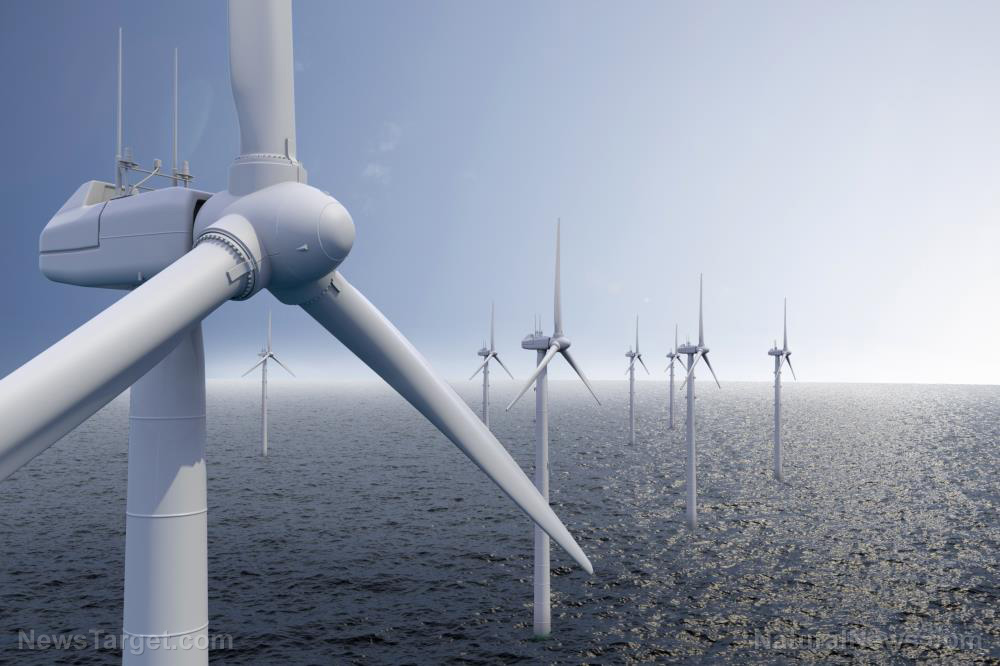 Parler
Parler Gab
Gab
The Biden Administration has recently produced a wave of plans and regulatory actions aimed at building a monstrous amount of destructive offshore wind. No environmental impact assessment is included.
(Article by David Wojick republished from CFact.org)
Time scales range from tomorrow to 2050. Here is a quick look at some of it, starting with the Grand Plan.
“Pathways to Commercial Liftoff: Offshore Wind” is the grandiose title of the Energy Department’s version of Biden’s vision. Their basic idea is that having successfully traversed the unexpected cost crisis, offshore wind is ready to take off.
They point out that even though costs quickly jumped an average of 65%, the boom market is unchanged. The coastal States are raring to go with huge offshore wind targets and laws. In short, it is a seller’s market. Cost is no object.
They note that State mandates and targets already exceed the Biden goal of 100,000 MW by 2050. But why stop there? They say that Net Zero requires an incredible 250,000 MW of offshore wind. At 15 MW a turbine, this is just under 17,000 monster towers.
The word “environmental” occurs frequently in this 62-page grand vision but it is always about environmental justice. The cumulatively destructive environmental impacts of lining our coast with towers and cables are ignored apparently not worth mentioning. Neither is cost.
Next comes transmission, where we have “AN ACTION PLAN FOR OFFSHORE WIND TRANSMISSION DEVELOPMENT IN THE U.S. ATLANTIC REGION“. While the Pathways plan covers the US, this one is just about the Atlantic because that is where the big action is now.
This 110-pager is from the Energy Department and the Bureau of Ocean Energy Management, which is actually building the offshore wind monster.
The basic idea is simple. Instead of bringing the juice ashore individually from each giant wind facility, we will build a massive high-voltage grid in the ocean. This way, we can move the energy up and down the coast from wherever it is generated to where it is needed.
In the Plan, there are actually three backbone grids: northern, central, and southern, but this detail need not concern us. There is, of course, a huge network of feeder lines connecting the backbones to the legion of individual giant generation facilities.
Given the incredibly huge generation numbers in the Liftoff Plan, this is a very big grid indeed. It is a DC grid, so I guess the juice gets turned into AC onshore, where it then ties to the suitably beefed-up land grid. Beefing that up is another huge unknown cost.
There are many issues with this grand design, including legal and policy ones, and many of these are mentioned. How this ocean-going grid ties into State utility law is an interesting example.
Environmental impacts are only addressed as a research topic, not as a potential problem, except for floating wind, where some big problems are mentioned in passing. The feel-good idea of minimizing impact occurs frequently, but what those impacts might be is not said.
As is typical for BOEM, they talk about monitoring a good bit. Their approach to environmental impact is let’s build it and see what happens as though extinction of the North Atlantic Right Whale was reversible. The concept of cumulative impacts is not addressed.
Cost allocation is a major economic topic, but there is nothing whatever on what this underwater monstrosity might cost.
Returning to today, several things have happened. First, BOEM has announced a lot of new lease sales over the next five years (the Biden II years?). These run from Maine to Oregon, fixed and floating, with five scheduled for this year alone.
Some are in new places, while others are in already crowded areas like the New York Bight. As always, there is no cumulative environmental impact analysis. It’s like BOEM never heard of that, even though the law clearly calls for it when piling on the projects.
More ominously, there are new regulations governing the permitting of offshore wind projects. The developers love these new rules, which tells us they are not designed for environmental protection. This is from the BOEM press release:
“”The final modernization rule will streamline the permitting process and reduce regulatory barriers for developers. It will also lead to greater collaboration between federal, state, and local stakeholders, ensuring that offshore wind projects are developed in a sustainable and responsible manner,” said Anne Reynolds, the American Clean Power Association Vice President for Offshore Wind.”
The primary “regulatory barrier” is environmental impact analysis. The new rules require agencies to rush these, which means glossing over them with no time for serious analysis.
Today’s actions may seem small, but given the long-term Plans, they are anything but. It is all part of a huge rush to do something enormously expensive and environmentally destructive for which there is no need whatsoever.
This offshore bulldozer must be stopped before it is too late.
Read more at: CFact.org
Rumble files $1 billion lawsuit against Google over lost ad revenue
By Arsenio Toledo // Share
By Richard Brown // Share
Draft official tells Spanish newspaper El Pais: Ukrainians are rejecting the army
By Kevin Hughes // Share
Tied of being called “anti” simply for having an opinion counter to someone else
By News Editors // Share
Britain’s support for Zionism has caused 76 years of conflict. It is time this barbarism stops
By News Editors // Share
The Nakba on screen: Five must watch films about the expulsion of Palestinians in 1948
By News Editors // Share
Governments continue to obscure COVID-19 vaccine data amid rising concerns over excess deaths
By patricklewis // Share
Tech giant Microsoft backs EXTINCTION with its support of carbon capture programs
By ramontomeydw // Share
Germany to resume arms exports to Israel despite repeated ceasefire violations
By isabelle // Share










